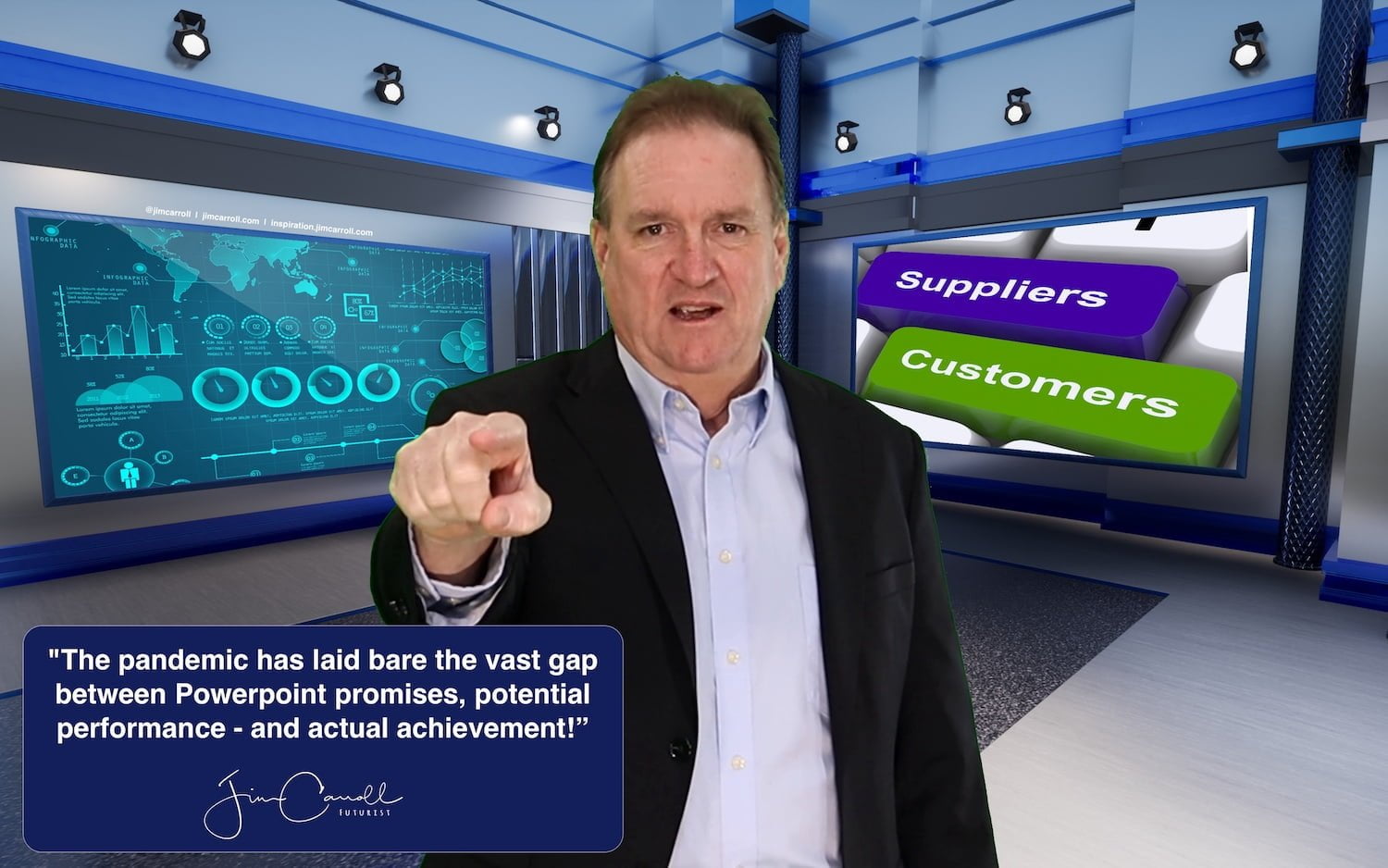“The pandemic has laid bare the vast gap between Powerpoint promises, potential performance – and actual achievement!” – Futurist Jim Carroll

We’ve come to expect so much more! Orders must be instant, perfect, on time, and without error. We should be able to instantly find any type of product anywhere at any time despite massively broken global supply chains. Manufacturing lines should continue to operate effortlessly without challenge, despite shortages of raw materials, semiconductors, and skilled workers. Prices should stay stable or decline while demand accelerates!
If the pandemic has done anything, it has widened the gap between those who plan and those who can. Incompetence is being laid bare; an inability to execute becomes instantly exposed; deficient strategies are suddenly shown to be worth their weight in failure.
Nothing makes sense anymore, and that’s the reality you must align to. Expectations have accelerated while capabilities have eroded, and the gap between promises and performance has continued to expand. The impact of Covid-19 has been that many organizations have discovered how to execute quickly, and if you have not bridged the gap between the promises of a Powerpoint presentation and actual execution, your possibilities for success are increasingly reduced. Bridge the gap!
The issue of the customer interaction gap is particularly acute. Does your organization have the right stuff to deal with todays’ information-empowered, globally collaborative, we-know-better-than-you-do customer? Maybe not! The bar of expectations has increased in today’s e-commerce, a curbside pickup-driven world, and you don’t just need to be excellent in customer relationships – you need to be relentlessly excellent!
These are the fundamental truths of the new customer relationship that I wrote into a post years ago. Now reconsider them in the context of our post-pandemic recovery:
- Fix things fast, because things break fast. As things go wrong, fix them fast. Have a communications plan. Be prepared to reassure the customer quickly. In this new era of hyper-information feedback, don’t let the customer sit and stew for a moment — proactive information and proactive action is the only weapon you have, and you have to use it.
- Adopt customer-niceness as a core virtue during the pain period. There are rules and fees and structures that can exist in any customer relationship. But make everyone aware on the team that there are likely some things that are going to have to be waived during the rollout. The core virtue is, “we’re going to be nice to the customer because we know it is not the customer’s fault that things have gone wrong.”
- Admit that mistakes will happen. It’s ok. It’s the 21st century. Bad things go wrong all the time. Accept that, and use that as a go-forward strategy. “Things will go wrong and we will work to fix them fast” is a better strategy than “we plan on rolling it out and holding our breath that things don’t get messed up.”
- Don’t hide from the customers. Customers today can turn on you in an instant. Rumors, stories, misinformation can abound. The customer has a lot of information, and might not always be reading it right — but they can certainly make it go wrong in a hurry. A clear, and open, and honest, reactive strategy with the customer is in your best interest. More communication is the best rule.
- Be open. Solicit feedback – get the customers on side. Don’t just roll out new ideas, technologies, services, or other things, and hope for the best. Know that there will be problems, issues, and things that will go wrong. Start out on the right foot with the customer base when things go wrong by admitting that you screwed up, and by seeking their input, guidance. The new business world is all a beta — Google gets this, and you should get this too.
- Turn customers into fixers. The customer is a new customer. They expect operational excellence, and if they don’t get it off the bat, they are prepared to help fix it. The complexity of a new customer software system can undergo all kinds of testing internally, but some things will never show up until it goes live. That’s why you want to recruit the customer as a problem solver. Turn it from a “bad rollout of new software” into something different, by letting the customer know that you want them to help stress test the system and find the things that aren’t working quite right.
- Get everyone inside on the same page. Let everyone throughout the organization know that something new is going to be happening that could cause customer stress. Get them to understand that the new JOB #1 is Customer-Destressification.
- Have an escalation plan. As things go wrong, be prepared to pump them up the chain in a hurry. Have a team ready to analyze what the customers are saying, do triage on the big ones, and work them quickly.
- Empower people with niceness. Customer-centricity and the instant-age demands that the customer be made happy — quickly. Give staff who have not previously had the authority, the authority to do things to the customer that are nice. That will help to ease the early part of the “pain process.”
- Learn from the experience. Learn from this rollout to figure out how to do it better the next time.
In today’s hyper-competitive environment, your customer relationship can be fleeting at best. They often know more about your market than your staff does. Act accordingly, or you look like a fool — and you end up losing customer loyalty.




GET IN TOUCH
Jim's Facebook page
You'll find Jim's latest videos on Youtube
Mastodon. What's on Jim's mind? Check his feed!
LinkedIn - reach out to Jim for a professional connection!
Flickr! Get inspired! A massive archive of all of Jim's daily inspirational quotes!
Instagram - the home for Jim's motivational mind!